Strategic Analysis and Recommendations for Marks & Spencer PLC
VerifiedAdded on 2020/06/06
|14
|3986
|27
Report
AI Summary
This report provides a comprehensive analysis of the business strategy of Marks & Spencer PLC, a British international retailer. It begins with an introduction to business strategy and an overview of Marks & Spencer, including its mission, vision, objectives, and core competencies. The report examines factors to consider when formulating a strategic plan, such as competition, industry trends, and strengths and weaknesses. It evaluates the effectiveness of the BCG matrix and SPACE analysis for Marks & Spencer. A detailed SWOT analysis, Ansoff matrix, PESTLE analysis, and Porter's five forces analysis are also included. The report concludes with a stakeholder analysis, providing insights into the interests and influence of various stakeholders. The report examines the change in responsibilities and role of personnel ineffectively implementing the business strategy and analyze the estimations for such requirements and provide SMART targets for M&S to ensure effective implementation of business policies.
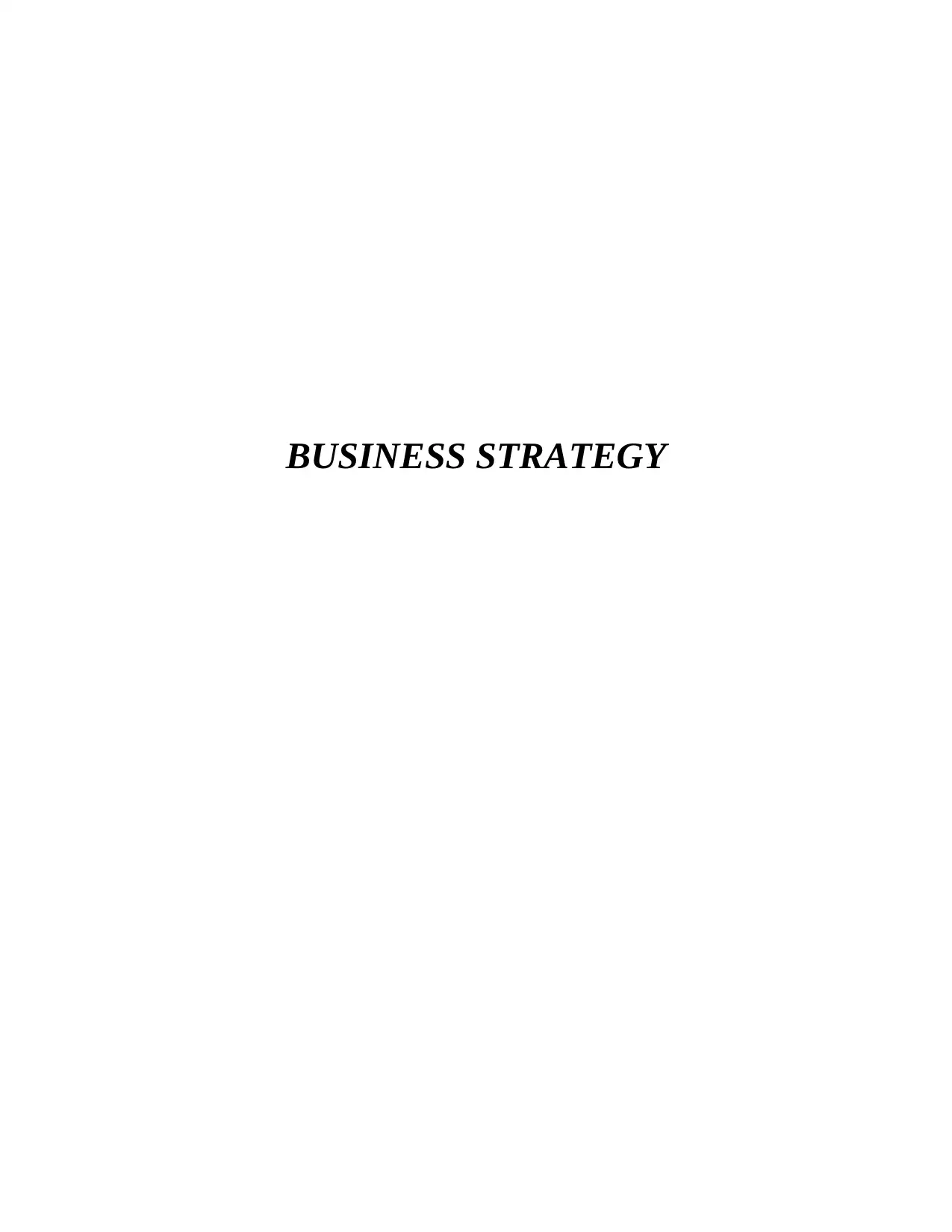
BUSINESS STRATEGY
Paraphrase This Document
Need a fresh take? Get an instant paraphrase of this document with our AI Paraphraser
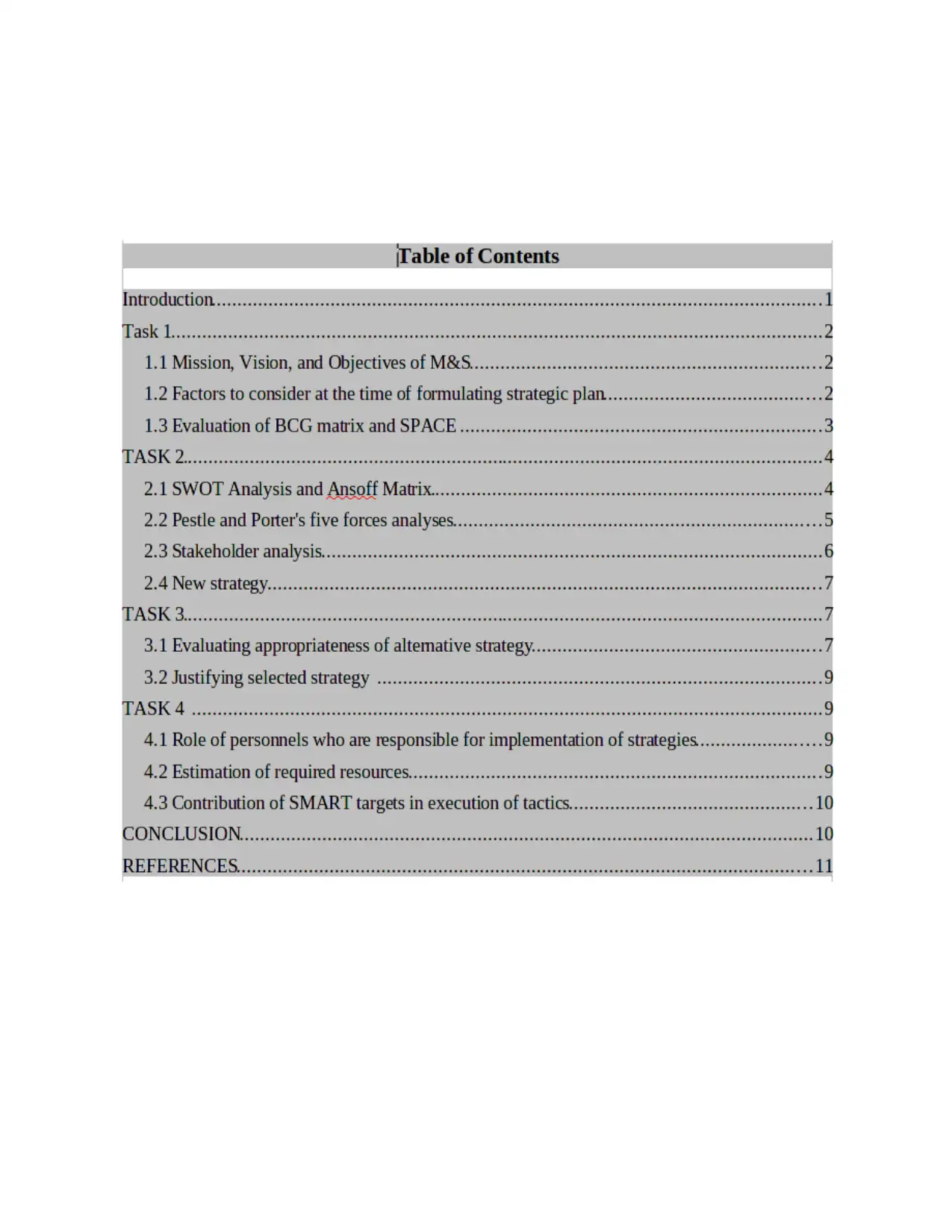

⊘ This is a preview!⊘
Do you want full access?
Subscribe today to unlock all pages.

Trusted by 1+ million students worldwide
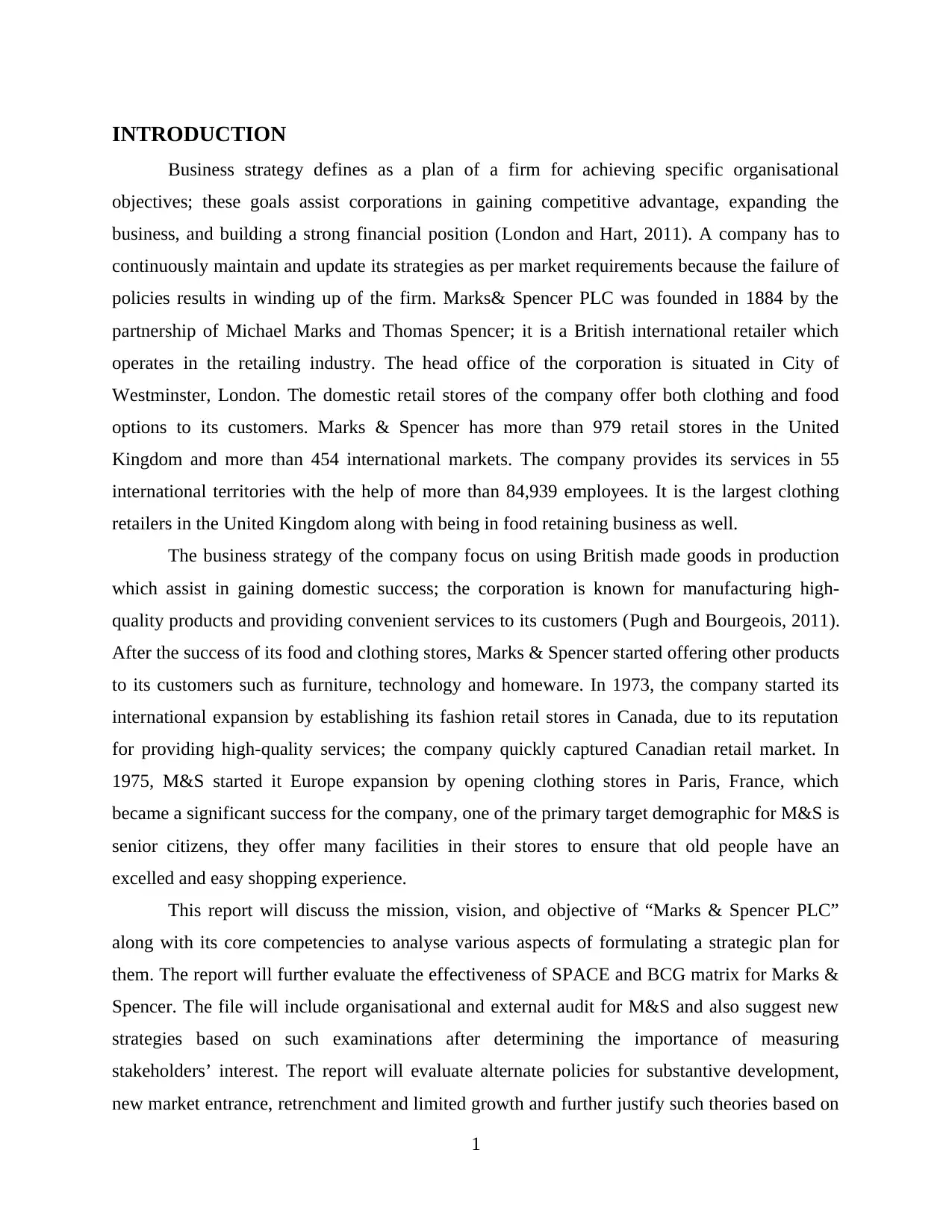
INTRODUCTION
Business strategy defines as a plan of a firm for achieving specific organisational
objectives; these goals assist corporations in gaining competitive advantage, expanding the
business, and building a strong financial position (London and Hart, 2011). A company has to
continuously maintain and update its strategies as per market requirements because the failure of
policies results in winding up of the firm. Marks& Spencer PLC was founded in 1884 by the
partnership of Michael Marks and Thomas Spencer; it is a British international retailer which
operates in the retailing industry. The head office of the corporation is situated in City of
Westminster, London. The domestic retail stores of the company offer both clothing and food
options to its customers. Marks & Spencer has more than 979 retail stores in the United
Kingdom and more than 454 international markets. The company provides its services in 55
international territories with the help of more than 84,939 employees. It is the largest clothing
retailers in the United Kingdom along with being in food retaining business as well.
The business strategy of the company focus on using British made goods in production
which assist in gaining domestic success; the corporation is known for manufacturing high-
quality products and providing convenient services to its customers (Pugh and Bourgeois, 2011).
After the success of its food and clothing stores, Marks & Spencer started offering other products
to its customers such as furniture, technology and homeware. In 1973, the company started its
international expansion by establishing its fashion retail stores in Canada, due to its reputation
for providing high-quality services; the company quickly captured Canadian retail market. In
1975, M&S started it Europe expansion by opening clothing stores in Paris, France, which
became a significant success for the company, one of the primary target demographic for M&S is
senior citizens, they offer many facilities in their stores to ensure that old people have an
excelled and easy shopping experience.
This report will discuss the mission, vision, and objective of “Marks & Spencer PLC”
along with its core competencies to analyse various aspects of formulating a strategic plan for
them. The report will further evaluate the effectiveness of SPACE and BCG matrix for Marks &
Spencer. The file will include organisational and external audit for M&S and also suggest new
strategies based on such examinations after determining the importance of measuring
stakeholders’ interest. The report will evaluate alternate policies for substantive development,
new market entrance, retrenchment and limited growth and further justify such theories based on
1
Business strategy defines as a plan of a firm for achieving specific organisational
objectives; these goals assist corporations in gaining competitive advantage, expanding the
business, and building a strong financial position (London and Hart, 2011). A company has to
continuously maintain and update its strategies as per market requirements because the failure of
policies results in winding up of the firm. Marks& Spencer PLC was founded in 1884 by the
partnership of Michael Marks and Thomas Spencer; it is a British international retailer which
operates in the retailing industry. The head office of the corporation is situated in City of
Westminster, London. The domestic retail stores of the company offer both clothing and food
options to its customers. Marks & Spencer has more than 979 retail stores in the United
Kingdom and more than 454 international markets. The company provides its services in 55
international territories with the help of more than 84,939 employees. It is the largest clothing
retailers in the United Kingdom along with being in food retaining business as well.
The business strategy of the company focus on using British made goods in production
which assist in gaining domestic success; the corporation is known for manufacturing high-
quality products and providing convenient services to its customers (Pugh and Bourgeois, 2011).
After the success of its food and clothing stores, Marks & Spencer started offering other products
to its customers such as furniture, technology and homeware. In 1973, the company started its
international expansion by establishing its fashion retail stores in Canada, due to its reputation
for providing high-quality services; the company quickly captured Canadian retail market. In
1975, M&S started it Europe expansion by opening clothing stores in Paris, France, which
became a significant success for the company, one of the primary target demographic for M&S is
senior citizens, they offer many facilities in their stores to ensure that old people have an
excelled and easy shopping experience.
This report will discuss the mission, vision, and objective of “Marks & Spencer PLC”
along with its core competencies to analyse various aspects of formulating a strategic plan for
them. The report will further evaluate the effectiveness of SPACE and BCG matrix for Marks &
Spencer. The file will include organisational and external audit for M&S and also suggest new
strategies based on such examinations after determining the importance of measuring
stakeholders’ interest. The report will evaluate alternate policies for substantive development,
new market entrance, retrenchment and limited growth and further justify such theories based on
1
Paraphrase This Document
Need a fresh take? Get an instant paraphrase of this document with our AI Paraphraser
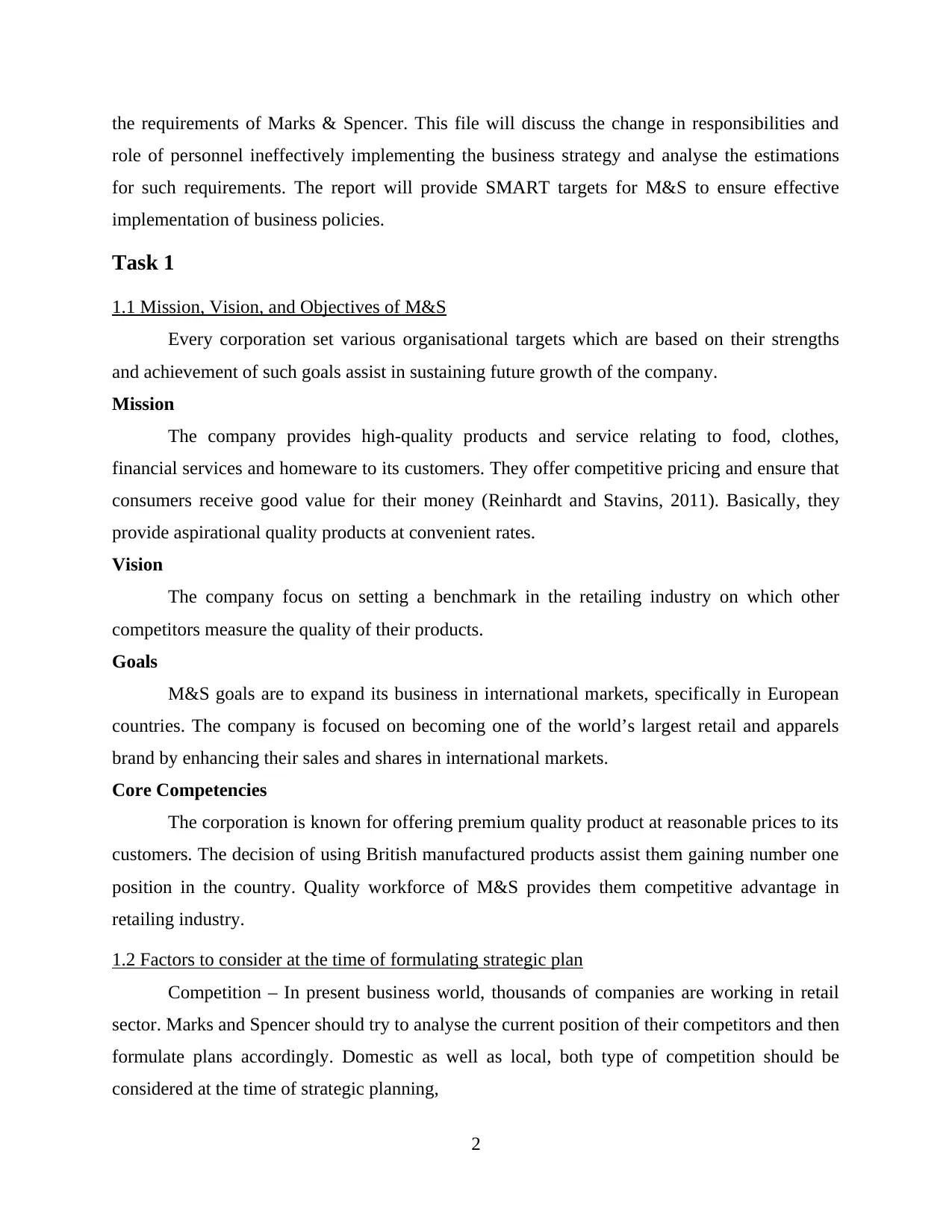
the requirements of Marks & Spencer. This file will discuss the change in responsibilities and
role of personnel ineffectively implementing the business strategy and analyse the estimations
for such requirements. The report will provide SMART targets for M&S to ensure effective
implementation of business policies.
Task 1
1.1 Mission, Vision, and Objectives of M&S
Every corporation set various organisational targets which are based on their strengths
and achievement of such goals assist in sustaining future growth of the company.
Mission
The company provides high-quality products and service relating to food, clothes,
financial services and homeware to its customers. They offer competitive pricing and ensure that
consumers receive good value for their money (Reinhardt and Stavins, 2011). Basically, they
provide aspirational quality products at convenient rates.
Vision
The company focus on setting a benchmark in the retailing industry on which other
competitors measure the quality of their products.
Goals
M&S goals are to expand its business in international markets, specifically in European
countries. The company is focused on becoming one of the world’s largest retail and apparels
brand by enhancing their sales and shares in international markets.
Core Competencies
The corporation is known for offering premium quality product at reasonable prices to its
customers. The decision of using British manufactured products assist them gaining number one
position in the country. Quality workforce of M&S provides them competitive advantage in
retailing industry.
1.2 Factors to consider at the time of formulating strategic plan
Competition – In present business world, thousands of companies are working in retail
sector. Marks and Spencer should try to analyse the current position of their competitors and then
formulate plans accordingly. Domestic as well as local, both type of competition should be
considered at the time of strategic planning,
2
role of personnel ineffectively implementing the business strategy and analyse the estimations
for such requirements. The report will provide SMART targets for M&S to ensure effective
implementation of business policies.
Task 1
1.1 Mission, Vision, and Objectives of M&S
Every corporation set various organisational targets which are based on their strengths
and achievement of such goals assist in sustaining future growth of the company.
Mission
The company provides high-quality products and service relating to food, clothes,
financial services and homeware to its customers. They offer competitive pricing and ensure that
consumers receive good value for their money (Reinhardt and Stavins, 2011). Basically, they
provide aspirational quality products at convenient rates.
Vision
The company focus on setting a benchmark in the retailing industry on which other
competitors measure the quality of their products.
Goals
M&S goals are to expand its business in international markets, specifically in European
countries. The company is focused on becoming one of the world’s largest retail and apparels
brand by enhancing their sales and shares in international markets.
Core Competencies
The corporation is known for offering premium quality product at reasonable prices to its
customers. The decision of using British manufactured products assist them gaining number one
position in the country. Quality workforce of M&S provides them competitive advantage in
retailing industry.
1.2 Factors to consider at the time of formulating strategic plan
Competition – In present business world, thousands of companies are working in retail
sector. Marks and Spencer should try to analyse the current position of their competitors and then
formulate plans accordingly. Domestic as well as local, both type of competition should be
considered at the time of strategic planning,
2
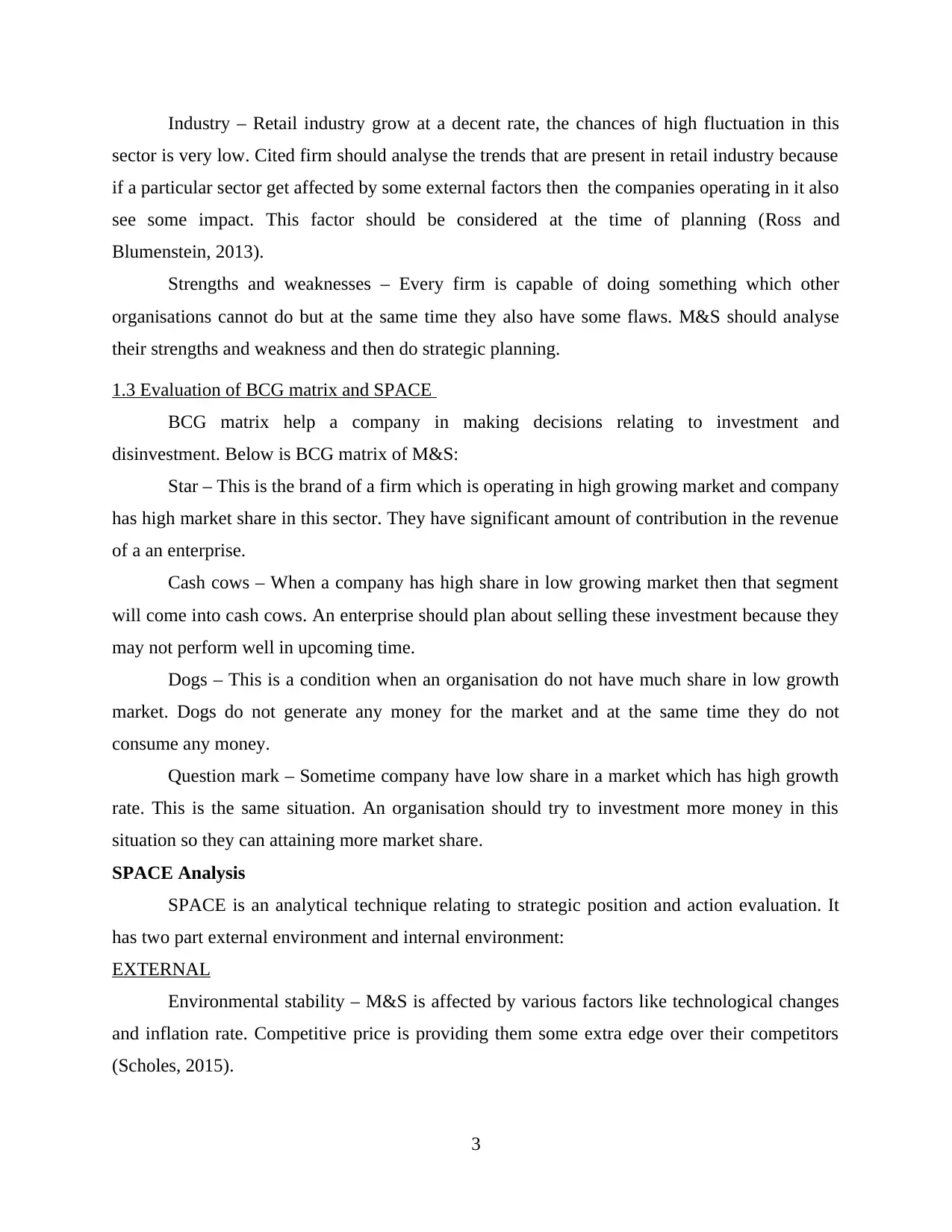
Industry – Retail industry grow at a decent rate, the chances of high fluctuation in this
sector is very low. Cited firm should analyse the trends that are present in retail industry because
if a particular sector get affected by some external factors then the companies operating in it also
see some impact. This factor should be considered at the time of planning (Ross and
Blumenstein, 2013).
Strengths and weaknesses – Every firm is capable of doing something which other
organisations cannot do but at the same time they also have some flaws. M&S should analyse
their strengths and weakness and then do strategic planning.
1.3 Evaluation of BCG matrix and SPACE
BCG matrix help a company in making decisions relating to investment and
disinvestment. Below is BCG matrix of M&S:
Star – This is the brand of a firm which is operating in high growing market and company
has high market share in this sector. They have significant amount of contribution in the revenue
of a an enterprise.
Cash cows – When a company has high share in low growing market then that segment
will come into cash cows. An enterprise should plan about selling these investment because they
may not perform well in upcoming time.
Dogs – This is a condition when an organisation do not have much share in low growth
market. Dogs do not generate any money for the market and at the same time they do not
consume any money.
Question mark – Sometime company have low share in a market which has high growth
rate. This is the same situation. An organisation should try to investment more money in this
situation so they can attaining more market share.
SPACE Analysis
SPACE is an analytical technique relating to strategic position and action evaluation. It
has two part external environment and internal environment:
EXTERNAL
Environmental stability – M&S is affected by various factors like technological changes
and inflation rate. Competitive price is providing them some extra edge over their competitors
(Scholes, 2015).
3
sector is very low. Cited firm should analyse the trends that are present in retail industry because
if a particular sector get affected by some external factors then the companies operating in it also
see some impact. This factor should be considered at the time of planning (Ross and
Blumenstein, 2013).
Strengths and weaknesses – Every firm is capable of doing something which other
organisations cannot do but at the same time they also have some flaws. M&S should analyse
their strengths and weakness and then do strategic planning.
1.3 Evaluation of BCG matrix and SPACE
BCG matrix help a company in making decisions relating to investment and
disinvestment. Below is BCG matrix of M&S:
Star – This is the brand of a firm which is operating in high growing market and company
has high market share in this sector. They have significant amount of contribution in the revenue
of a an enterprise.
Cash cows – When a company has high share in low growing market then that segment
will come into cash cows. An enterprise should plan about selling these investment because they
may not perform well in upcoming time.
Dogs – This is a condition when an organisation do not have much share in low growth
market. Dogs do not generate any money for the market and at the same time they do not
consume any money.
Question mark – Sometime company have low share in a market which has high growth
rate. This is the same situation. An organisation should try to investment more money in this
situation so they can attaining more market share.
SPACE Analysis
SPACE is an analytical technique relating to strategic position and action evaluation. It
has two part external environment and internal environment:
EXTERNAL
Environmental stability – M&S is affected by various factors like technological changes
and inflation rate. Competitive price is providing them some extra edge over their competitors
(Scholes, 2015).
3
⊘ This is a preview!⊘
Do you want full access?
Subscribe today to unlock all pages.

Trusted by 1+ million students worldwide
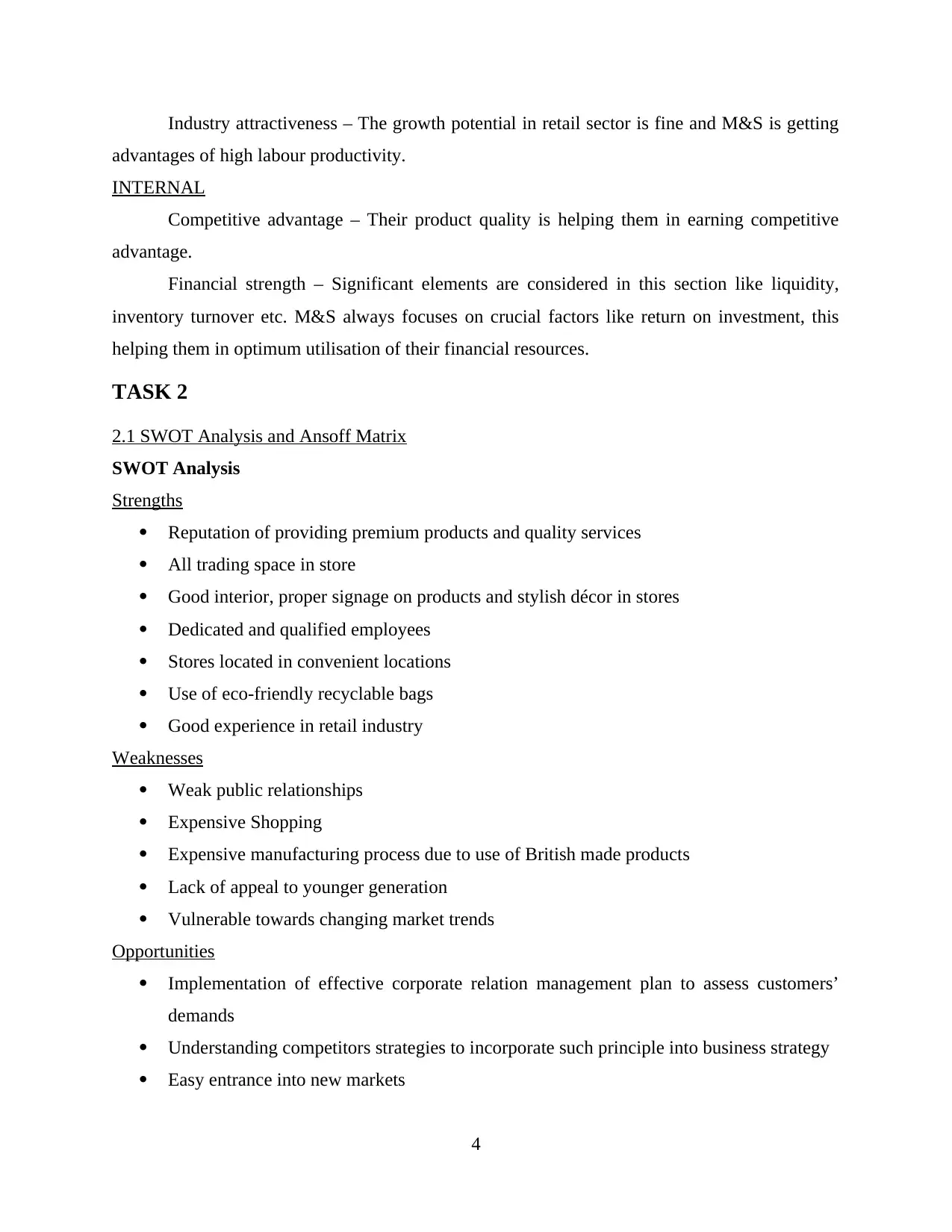
Industry attractiveness – The growth potential in retail sector is fine and M&S is getting
advantages of high labour productivity.
INTERNAL
Competitive advantage – Their product quality is helping them in earning competitive
advantage.
Financial strength – Significant elements are considered in this section like liquidity,
inventory turnover etc. M&S always focuses on crucial factors like return on investment, this
helping them in optimum utilisation of their financial resources.
TASK 2
2.1 SWOT Analysis and Ansoff Matrix
SWOT Analysis
Strengths
Reputation of providing premium products and quality services
All trading space in store
Good interior, proper signage on products and stylish décor in stores
Dedicated and qualified employees
Stores located in convenient locations
Use of eco-friendly recyclable bags
Good experience in retail industry
Weaknesses
Weak public relationships
Expensive Shopping
Expensive manufacturing process due to use of British made products
Lack of appeal to younger generation
Vulnerable towards changing market trends
Opportunities
Implementation of effective corporate relation management plan to assess customers’
demands
Understanding competitors strategies to incorporate such principle into business strategy
Easy entrance into new markets
4
advantages of high labour productivity.
INTERNAL
Competitive advantage – Their product quality is helping them in earning competitive
advantage.
Financial strength – Significant elements are considered in this section like liquidity,
inventory turnover etc. M&S always focuses on crucial factors like return on investment, this
helping them in optimum utilisation of their financial resources.
TASK 2
2.1 SWOT Analysis and Ansoff Matrix
SWOT Analysis
Strengths
Reputation of providing premium products and quality services
All trading space in store
Good interior, proper signage on products and stylish décor in stores
Dedicated and qualified employees
Stores located in convenient locations
Use of eco-friendly recyclable bags
Good experience in retail industry
Weaknesses
Weak public relationships
Expensive Shopping
Expensive manufacturing process due to use of British made products
Lack of appeal to younger generation
Vulnerable towards changing market trends
Opportunities
Implementation of effective corporate relation management plan to assess customers’
demands
Understanding competitors strategies to incorporate such principle into business strategy
Easy entrance into new markets
4
Paraphrase This Document
Need a fresh take? Get an instant paraphrase of this document with our AI Paraphraser
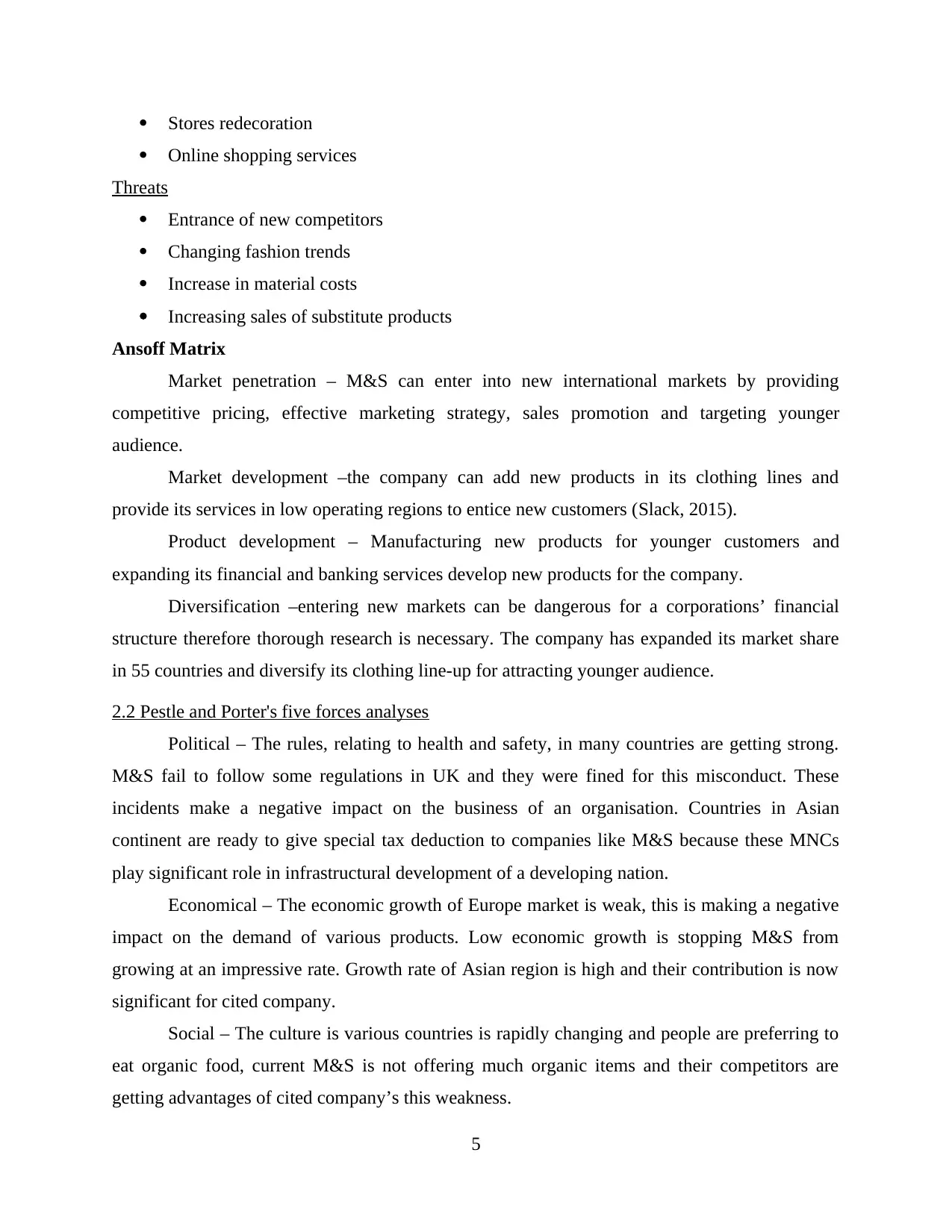
Stores redecoration
Online shopping services
Threats
Entrance of new competitors
Changing fashion trends
Increase in material costs
Increasing sales of substitute products
Ansoff Matrix
Market penetration – M&S can enter into new international markets by providing
competitive pricing, effective marketing strategy, sales promotion and targeting younger
audience.
Market development –the company can add new products in its clothing lines and
provide its services in low operating regions to entice new customers (Slack, 2015).
Product development – Manufacturing new products for younger customers and
expanding its financial and banking services develop new products for the company.
Diversification –entering new markets can be dangerous for a corporations’ financial
structure therefore thorough research is necessary. The company has expanded its market share
in 55 countries and diversify its clothing line-up for attracting younger audience.
2.2 Pestle and Porter's five forces analyses
Political – The rules, relating to health and safety, in many countries are getting strong.
M&S fail to follow some regulations in UK and they were fined for this misconduct. These
incidents make a negative impact on the business of an organisation. Countries in Asian
continent are ready to give special tax deduction to companies like M&S because these MNCs
play significant role in infrastructural development of a developing nation.
Economical – The economic growth of Europe market is weak, this is making a negative
impact on the demand of various products. Low economic growth is stopping M&S from
growing at an impressive rate. Growth rate of Asian region is high and their contribution is now
significant for cited company.
Social – The culture is various countries is rapidly changing and people are preferring to
eat organic food, current M&S is not offering much organic items and their competitors are
getting advantages of cited company’s this weakness.
5
Online shopping services
Threats
Entrance of new competitors
Changing fashion trends
Increase in material costs
Increasing sales of substitute products
Ansoff Matrix
Market penetration – M&S can enter into new international markets by providing
competitive pricing, effective marketing strategy, sales promotion and targeting younger
audience.
Market development –the company can add new products in its clothing lines and
provide its services in low operating regions to entice new customers (Slack, 2015).
Product development – Manufacturing new products for younger customers and
expanding its financial and banking services develop new products for the company.
Diversification –entering new markets can be dangerous for a corporations’ financial
structure therefore thorough research is necessary. The company has expanded its market share
in 55 countries and diversify its clothing line-up for attracting younger audience.
2.2 Pestle and Porter's five forces analyses
Political – The rules, relating to health and safety, in many countries are getting strong.
M&S fail to follow some regulations in UK and they were fined for this misconduct. These
incidents make a negative impact on the business of an organisation. Countries in Asian
continent are ready to give special tax deduction to companies like M&S because these MNCs
play significant role in infrastructural development of a developing nation.
Economical – The economic growth of Europe market is weak, this is making a negative
impact on the demand of various products. Low economic growth is stopping M&S from
growing at an impressive rate. Growth rate of Asian region is high and their contribution is now
significant for cited company.
Social – The culture is various countries is rapidly changing and people are preferring to
eat organic food, current M&S is not offering much organic items and their competitors are
getting advantages of cited company’s this weakness.
5
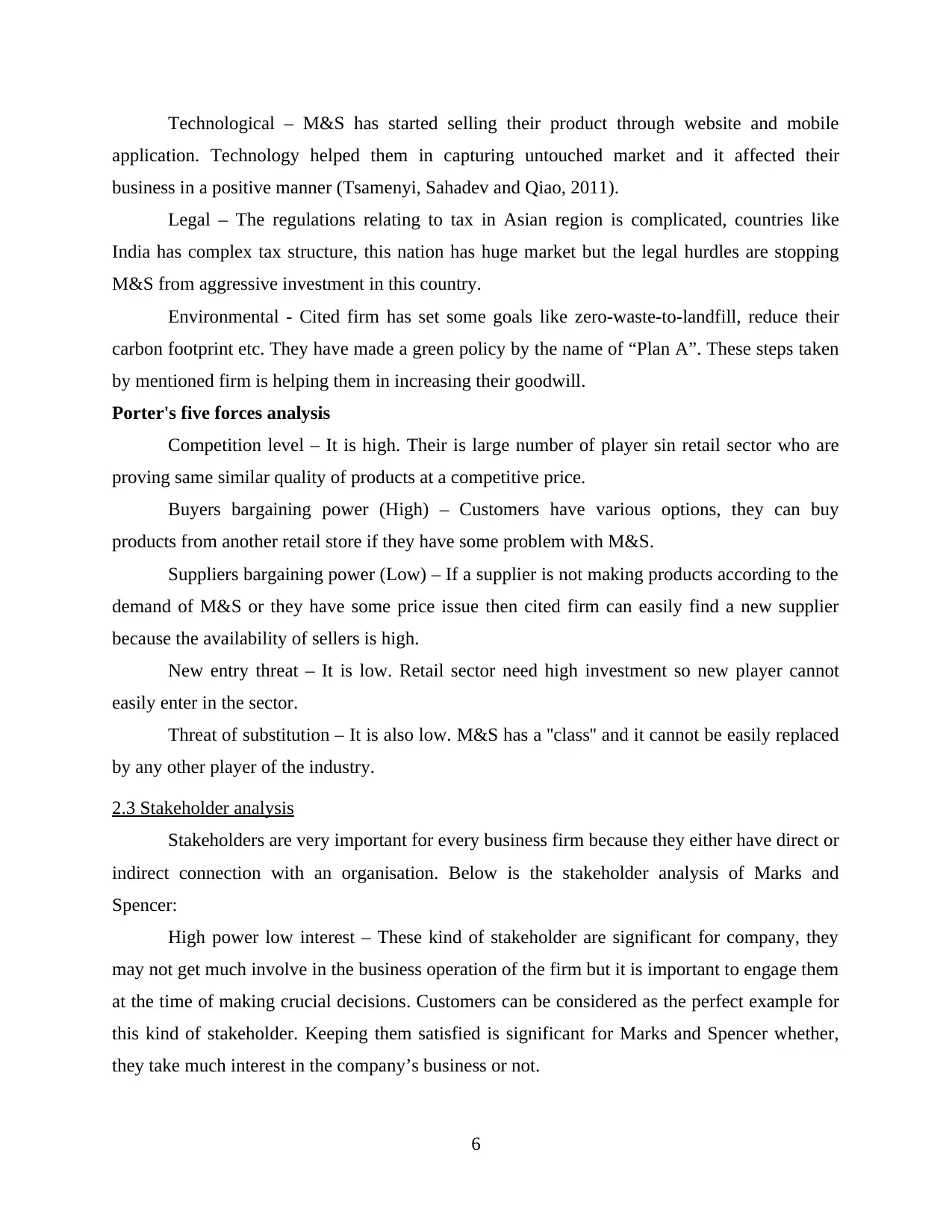
Technological – M&S has started selling their product through website and mobile
application. Technology helped them in capturing untouched market and it affected their
business in a positive manner (Tsamenyi, Sahadev and Qiao, 2011).
Legal – The regulations relating to tax in Asian region is complicated, countries like
India has complex tax structure, this nation has huge market but the legal hurdles are stopping
M&S from aggressive investment in this country.
Environmental - Cited firm has set some goals like zero-waste-to-landfill, reduce their
carbon footprint etc. They have made a green policy by the name of “Plan A”. These steps taken
by mentioned firm is helping them in increasing their goodwill.
Porter's five forces analysis
Competition level – It is high. Their is large number of player sin retail sector who are
proving same similar quality of products at a competitive price.
Buyers bargaining power (High) – Customers have various options, they can buy
products from another retail store if they have some problem with M&S.
Suppliers bargaining power (Low) – If a supplier is not making products according to the
demand of M&S or they have some price issue then cited firm can easily find a new supplier
because the availability of sellers is high.
New entry threat – It is low. Retail sector need high investment so new player cannot
easily enter in the sector.
Threat of substitution – It is also low. M&S has a ''class'' and it cannot be easily replaced
by any other player of the industry.
2.3 Stakeholder analysis
Stakeholders are very important for every business firm because they either have direct or
indirect connection with an organisation. Below is the stakeholder analysis of Marks and
Spencer:
High power low interest – These kind of stakeholder are significant for company, they
may not get much involve in the business operation of the firm but it is important to engage them
at the time of making crucial decisions. Customers can be considered as the perfect example for
this kind of stakeholder. Keeping them satisfied is significant for Marks and Spencer whether,
they take much interest in the company’s business or not.
6
application. Technology helped them in capturing untouched market and it affected their
business in a positive manner (Tsamenyi, Sahadev and Qiao, 2011).
Legal – The regulations relating to tax in Asian region is complicated, countries like
India has complex tax structure, this nation has huge market but the legal hurdles are stopping
M&S from aggressive investment in this country.
Environmental - Cited firm has set some goals like zero-waste-to-landfill, reduce their
carbon footprint etc. They have made a green policy by the name of “Plan A”. These steps taken
by mentioned firm is helping them in increasing their goodwill.
Porter's five forces analysis
Competition level – It is high. Their is large number of player sin retail sector who are
proving same similar quality of products at a competitive price.
Buyers bargaining power (High) – Customers have various options, they can buy
products from another retail store if they have some problem with M&S.
Suppliers bargaining power (Low) – If a supplier is not making products according to the
demand of M&S or they have some price issue then cited firm can easily find a new supplier
because the availability of sellers is high.
New entry threat – It is low. Retail sector need high investment so new player cannot
easily enter in the sector.
Threat of substitution – It is also low. M&S has a ''class'' and it cannot be easily replaced
by any other player of the industry.
2.3 Stakeholder analysis
Stakeholders are very important for every business firm because they either have direct or
indirect connection with an organisation. Below is the stakeholder analysis of Marks and
Spencer:
High power low interest – These kind of stakeholder are significant for company, they
may not get much involve in the business operation of the firm but it is important to engage them
at the time of making crucial decisions. Customers can be considered as the perfect example for
this kind of stakeholder. Keeping them satisfied is significant for Marks and Spencer whether,
they take much interest in the company’s business or not.
6
⊘ This is a preview!⊘
Do you want full access?
Subscribe today to unlock all pages.

Trusted by 1+ million students worldwide
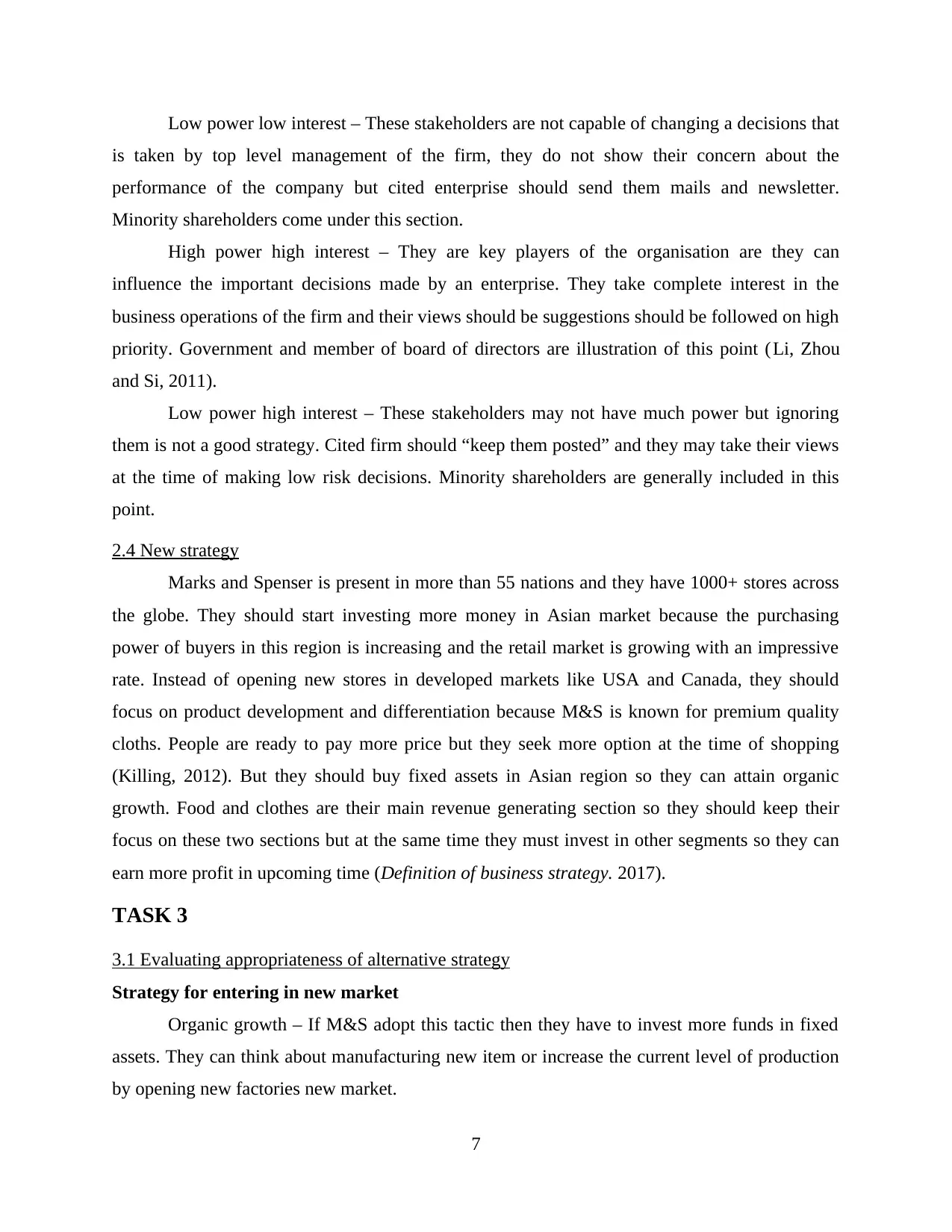
Low power low interest – These stakeholders are not capable of changing a decisions that
is taken by top level management of the firm, they do not show their concern about the
performance of the company but cited enterprise should send them mails and newsletter.
Minority shareholders come under this section.
High power high interest – They are key players of the organisation are they can
influence the important decisions made by an enterprise. They take complete interest in the
business operations of the firm and their views should be suggestions should be followed on high
priority. Government and member of board of directors are illustration of this point (Li, Zhou
and Si, 2011).
Low power high interest – These stakeholders may not have much power but ignoring
them is not a good strategy. Cited firm should “keep them posted” and they may take their views
at the time of making low risk decisions. Minority shareholders are generally included in this
point.
2.4 New strategy
Marks and Spenser is present in more than 55 nations and they have 1000+ stores across
the globe. They should start investing more money in Asian market because the purchasing
power of buyers in this region is increasing and the retail market is growing with an impressive
rate. Instead of opening new stores in developed markets like USA and Canada, they should
focus on product development and differentiation because M&S is known for premium quality
cloths. People are ready to pay more price but they seek more option at the time of shopping
(Killing, 2012). But they should buy fixed assets in Asian region so they can attain organic
growth. Food and clothes are their main revenue generating section so they should keep their
focus on these two sections but at the same time they must invest in other segments so they can
earn more profit in upcoming time (Definition of business strategy. 2017).
TASK 3
3.1 Evaluating appropriateness of alternative strategy
Strategy for entering in new market
Organic growth – If M&S adopt this tactic then they have to invest more funds in fixed
assets. They can think about manufacturing new item or increase the current level of production
by opening new factories new market.
7
is taken by top level management of the firm, they do not show their concern about the
performance of the company but cited enterprise should send them mails and newsletter.
Minority shareholders come under this section.
High power high interest – They are key players of the organisation are they can
influence the important decisions made by an enterprise. They take complete interest in the
business operations of the firm and their views should be suggestions should be followed on high
priority. Government and member of board of directors are illustration of this point (Li, Zhou
and Si, 2011).
Low power high interest – These stakeholders may not have much power but ignoring
them is not a good strategy. Cited firm should “keep them posted” and they may take their views
at the time of making low risk decisions. Minority shareholders are generally included in this
point.
2.4 New strategy
Marks and Spenser is present in more than 55 nations and they have 1000+ stores across
the globe. They should start investing more money in Asian market because the purchasing
power of buyers in this region is increasing and the retail market is growing with an impressive
rate. Instead of opening new stores in developed markets like USA and Canada, they should
focus on product development and differentiation because M&S is known for premium quality
cloths. People are ready to pay more price but they seek more option at the time of shopping
(Killing, 2012). But they should buy fixed assets in Asian region so they can attain organic
growth. Food and clothes are their main revenue generating section so they should keep their
focus on these two sections but at the same time they must invest in other segments so they can
earn more profit in upcoming time (Definition of business strategy. 2017).
TASK 3
3.1 Evaluating appropriateness of alternative strategy
Strategy for entering in new market
Organic growth – If M&S adopt this tactic then they have to invest more funds in fixed
assets. They can think about manufacturing new item or increase the current level of production
by opening new factories new market.
7
Paraphrase This Document
Need a fresh take? Get an instant paraphrase of this document with our AI Paraphraser
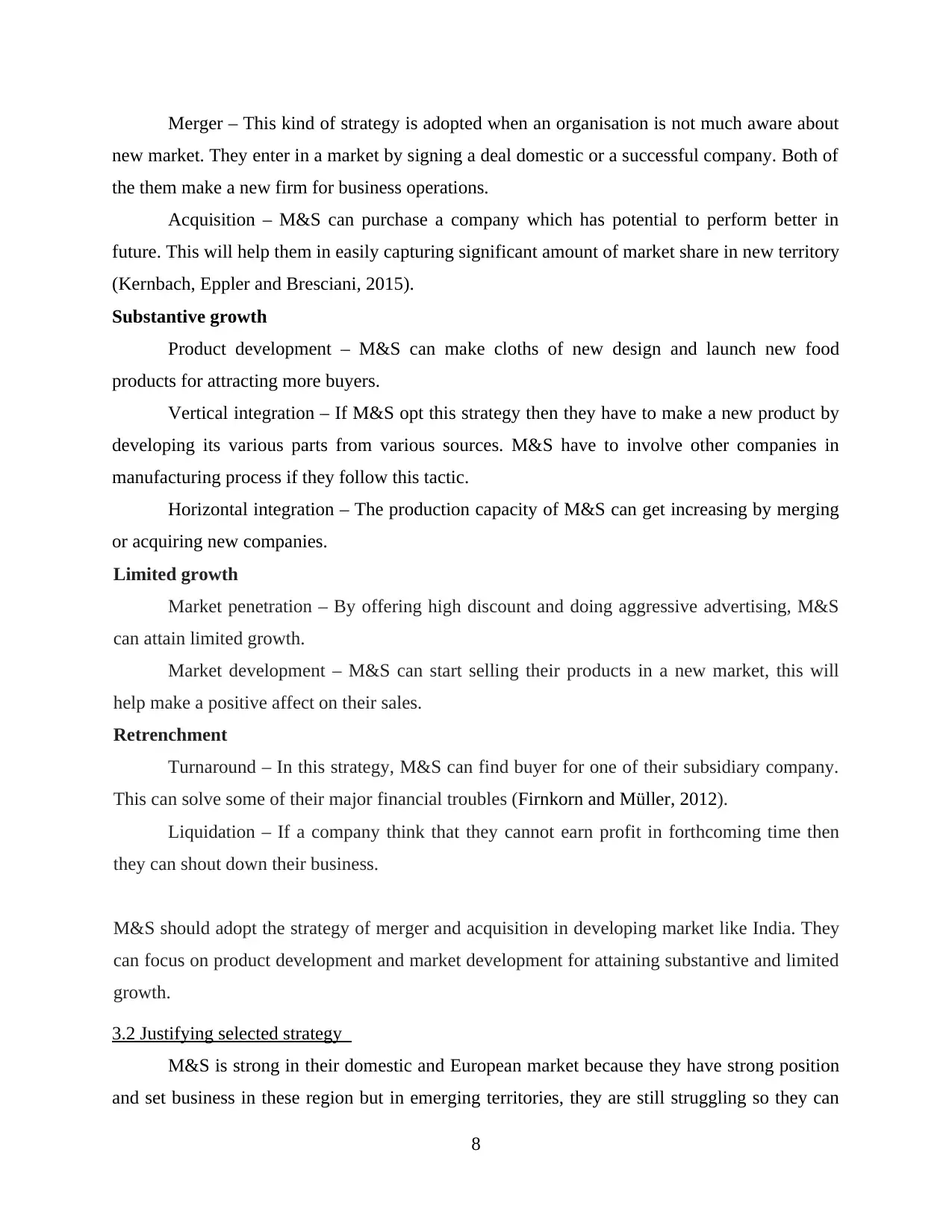
Merger – This kind of strategy is adopted when an organisation is not much aware about
new market. They enter in a market by signing a deal domestic or a successful company. Both of
the them make a new firm for business operations.
Acquisition – M&S can purchase a company which has potential to perform better in
future. This will help them in easily capturing significant amount of market share in new territory
(Kernbach, Eppler and Bresciani, 2015).
Substantive growth
Product development – M&S can make cloths of new design and launch new food
products for attracting more buyers.
Vertical integration – If M&S opt this strategy then they have to make a new product by
developing its various parts from various sources. M&S have to involve other companies in
manufacturing process if they follow this tactic.
Horizontal integration – The production capacity of M&S can get increasing by merging
or acquiring new companies.
Limited growth
Market penetration – By offering high discount and doing aggressive advertising, M&S
can attain limited growth.
Market development – M&S can start selling their products in a new market, this will
help make a positive affect on their sales.
Retrenchment
Turnaround – In this strategy, M&S can find buyer for one of their subsidiary company.
This can solve some of their major financial troubles (Firnkorn and Müller, 2012).
Liquidation – If a company think that they cannot earn profit in forthcoming time then
they can shout down their business.
M&S should adopt the strategy of merger and acquisition in developing market like India. They
can focus on product development and market development for attaining substantive and limited
growth.
3.2 Justifying selected strategy
M&S is strong in their domestic and European market because they have strong position
and set business in these region but in emerging territories, they are still struggling so they can
8
new market. They enter in a market by signing a deal domestic or a successful company. Both of
the them make a new firm for business operations.
Acquisition – M&S can purchase a company which has potential to perform better in
future. This will help them in easily capturing significant amount of market share in new territory
(Kernbach, Eppler and Bresciani, 2015).
Substantive growth
Product development – M&S can make cloths of new design and launch new food
products for attracting more buyers.
Vertical integration – If M&S opt this strategy then they have to make a new product by
developing its various parts from various sources. M&S have to involve other companies in
manufacturing process if they follow this tactic.
Horizontal integration – The production capacity of M&S can get increasing by merging
or acquiring new companies.
Limited growth
Market penetration – By offering high discount and doing aggressive advertising, M&S
can attain limited growth.
Market development – M&S can start selling their products in a new market, this will
help make a positive affect on their sales.
Retrenchment
Turnaround – In this strategy, M&S can find buyer for one of their subsidiary company.
This can solve some of their major financial troubles (Firnkorn and Müller, 2012).
Liquidation – If a company think that they cannot earn profit in forthcoming time then
they can shout down their business.
M&S should adopt the strategy of merger and acquisition in developing market like India. They
can focus on product development and market development for attaining substantive and limited
growth.
3.2 Justifying selected strategy
M&S is strong in their domestic and European market because they have strong position
and set business in these region but in emerging territories, they are still struggling so they can
8
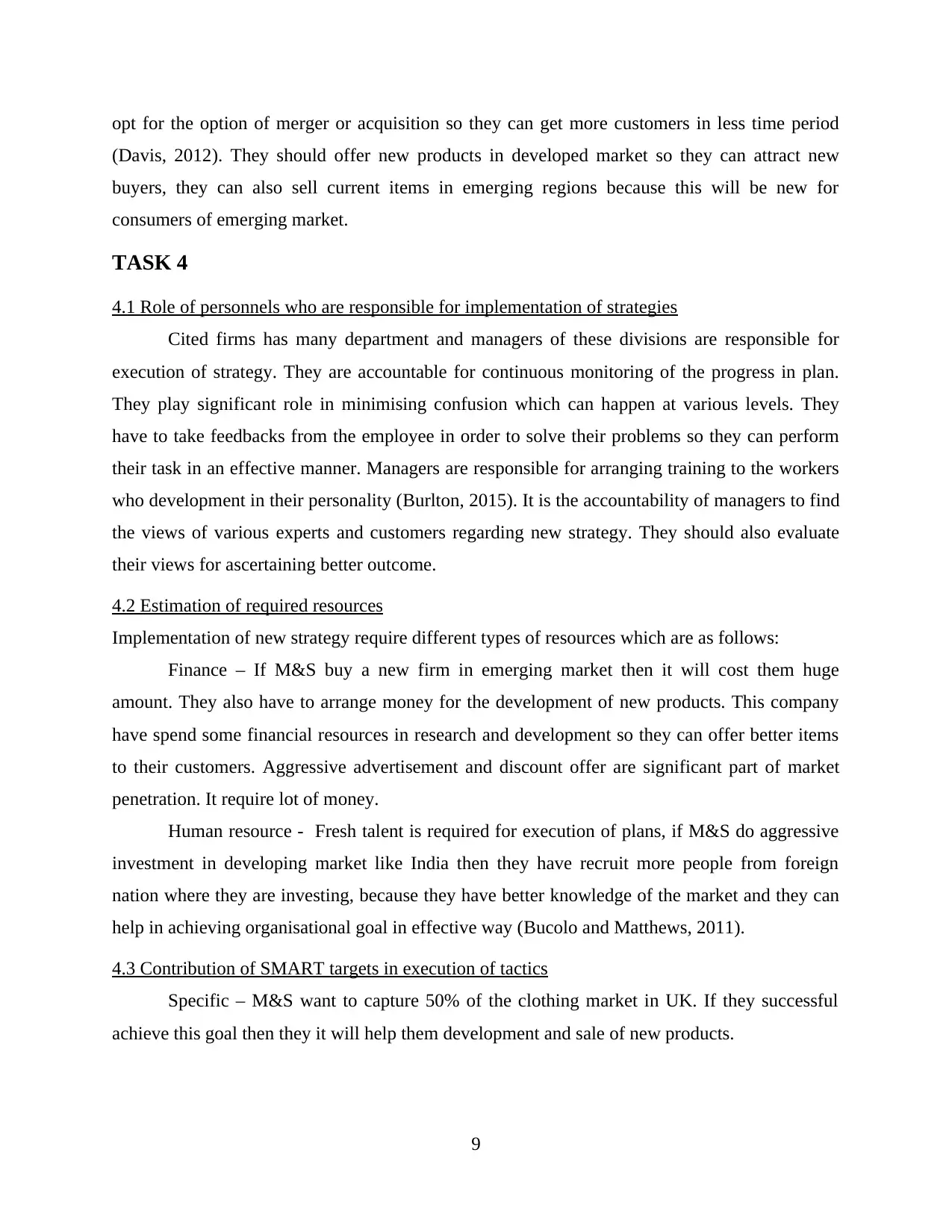
opt for the option of merger or acquisition so they can get more customers in less time period
(Davis, 2012). They should offer new products in developed market so they can attract new
buyers, they can also sell current items in emerging regions because this will be new for
consumers of emerging market.
TASK 4
4.1 Role of personnels who are responsible for implementation of strategies
Cited firms has many department and managers of these divisions are responsible for
execution of strategy. They are accountable for continuous monitoring of the progress in plan.
They play significant role in minimising confusion which can happen at various levels. They
have to take feedbacks from the employee in order to solve their problems so they can perform
their task in an effective manner. Managers are responsible for arranging training to the workers
who development in their personality (Burlton, 2015). It is the accountability of managers to find
the views of various experts and customers regarding new strategy. They should also evaluate
their views for ascertaining better outcome.
4.2 Estimation of required resources
Implementation of new strategy require different types of resources which are as follows:
Finance – If M&S buy a new firm in emerging market then it will cost them huge
amount. They also have to arrange money for the development of new products. This company
have spend some financial resources in research and development so they can offer better items
to their customers. Aggressive advertisement and discount offer are significant part of market
penetration. It require lot of money.
Human resource - Fresh talent is required for execution of plans, if M&S do aggressive
investment in developing market like India then they have recruit more people from foreign
nation where they are investing, because they have better knowledge of the market and they can
help in achieving organisational goal in effective way (Bucolo and Matthews, 2011).
4.3 Contribution of SMART targets in execution of tactics
Specific – M&S want to capture 50% of the clothing market in UK. If they successful
achieve this goal then they it will help them development and sale of new products.
9
(Davis, 2012). They should offer new products in developed market so they can attract new
buyers, they can also sell current items in emerging regions because this will be new for
consumers of emerging market.
TASK 4
4.1 Role of personnels who are responsible for implementation of strategies
Cited firms has many department and managers of these divisions are responsible for
execution of strategy. They are accountable for continuous monitoring of the progress in plan.
They play significant role in minimising confusion which can happen at various levels. They
have to take feedbacks from the employee in order to solve their problems so they can perform
their task in an effective manner. Managers are responsible for arranging training to the workers
who development in their personality (Burlton, 2015). It is the accountability of managers to find
the views of various experts and customers regarding new strategy. They should also evaluate
their views for ascertaining better outcome.
4.2 Estimation of required resources
Implementation of new strategy require different types of resources which are as follows:
Finance – If M&S buy a new firm in emerging market then it will cost them huge
amount. They also have to arrange money for the development of new products. This company
have spend some financial resources in research and development so they can offer better items
to their customers. Aggressive advertisement and discount offer are significant part of market
penetration. It require lot of money.
Human resource - Fresh talent is required for execution of plans, if M&S do aggressive
investment in developing market like India then they have recruit more people from foreign
nation where they are investing, because they have better knowledge of the market and they can
help in achieving organisational goal in effective way (Bucolo and Matthews, 2011).
4.3 Contribution of SMART targets in execution of tactics
Specific – M&S want to capture 50% of the clothing market in UK. If they successful
achieve this goal then they it will help them development and sale of new products.
9
⊘ This is a preview!⊘
Do you want full access?
Subscribe today to unlock all pages.

Trusted by 1+ million students worldwide
1 out of 14
Related Documents
Your All-in-One AI-Powered Toolkit for Academic Success.
+13062052269
info@desklib.com
Available 24*7 on WhatsApp / Email
![[object Object]](/_next/static/media/star-bottom.7253800d.svg)
Unlock your academic potential
Copyright © 2020–2025 A2Z Services. All Rights Reserved. Developed and managed by ZUCOL.





